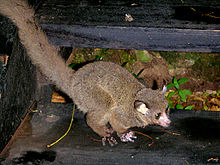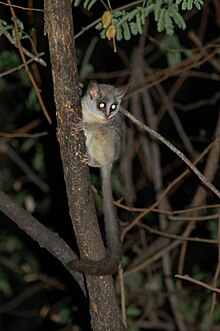Galagos
| Galagos | ||||||||||||
|---|---|---|---|---|---|---|---|---|---|---|---|---|

Senegal Galago ( Galago senegalensis ) |
||||||||||||
| Systematics | ||||||||||||
|
||||||||||||
| Scientific name | ||||||||||||
| Galagonidae | ||||||||||||
| Gray , 1825 |
The Galagos (Galagonidae or Galagidae), also bush babies called, are a primate family from the group of wet proboscis monkeys (formerly " prosimians allocated"). They are small, nocturnal primates that are mainly in trees. The family includes around 20 species, all of which are native to Africa .
features
Galagos are relatively small primates. The largest representatives are the giant galagos with 0.6 to 2 kilograms, the other species reach between 0.05 and 0.4 kilograms. The head-trunk length is 7 to 40 centimeters and the tail length 11 to 55 centimeters. The tail is always longer than the body; in some representatives it is extremely bushy. The hind legs are longer than the front legs, characteristic are the strongly elongated tarsus . All fingers and toes end in nails with the exception of the second toe, which, like all wet-nosed monkeys, has a cleaning claw . The second finger is shortened, albeit to a lesser extent than that of the Loris , their closest relatives.
The coat of the Galagos is soft and woolly. It is kept in inconspicuous, lackluster brown or gray tones, with the underside being a bit lighter.
The head of the Galagos is characterized by the enlarged eyes and ears. The enlargement of the eyes represents an adaptation to the nocturnal way of life, the eye sockets are slightly turned outwards. The ears are provided with several transverse grooves and can be folded in independently of each other. The tooth formula is I 2 / 2- C 1 / 1- P 3 / 3- M 3/3, so a total of 36 teeth. As with most wet-nosed monkeys, the lower incisors and canines form a forward-facing tooth comb .
distribution and habitat
Galagos are native to Africa south of the Sahara , their range extends from Senegal and Ethiopia to northern South Africa . However , they are missing in Madagascar . The habitat of these animals are tree-lined areas; in addition to rainforest dwellers, there are also species that can cope with drier habitats such as savannahs. Some species are used to being close to humans and also live in parks and gardens.
Way of life
Galagos are nocturnal, during the day they sleep in leaf nests or in tree hollows. At night they go looking for food, mostly in the trees. Your movements are quick and skillful. Some species are adapted to a vertically climbing and jumping way of life, others tend to move around on all fours, running and hopping.
Social behavior is variable and little researched in many species. Most Galagos go foraging alone, but sometimes sleep with other members of their own in a common camp. Many species are territorial, they often urinate on their hands and thereby mark their home territory when climbing. Males are often aggressive towards other males, but the territory of one male can overlap with that of several females. There are also species that live in small groups.
They owe their name “bush babies” to their infant-like screams, with which they draw the attention of other animals to their territory.
food
The food of the Galagos consists mainly of insects, fruits and tree sap. Tree saps play an important role, especially when there is a shortage of fruit, the Kielnagelgalagos are specially adapted to this food thanks to specialized fingernails and teeth. However, there are also species that feed almost exclusively on insects or fruits. The composition of the diet not only varies between species, there can also be significant differences in diet within a species, depending on the habitat or season.
Reproduction
Once or twice a year, the female gives birth to one to three young animals after a gestation period of around 110 to 140 days. Often the mother builds her own nest of leaves for the birth and the first few weeks of life, when she changes location she often carries the young in her mouth. After around two to five months they are weaned and sexually mature at one to two years. Animals in human captivity can reach an age of over 18 years, in the wild life expectancy is probably lower and is rarely more than eight years.
Galagos and people
Galagos are locally very common and less endangered than other African primate species. They are relatively adaptable and can cope with open habitats, and because of their small size, they are rarely hunted. According to the IUCN, many species are not endangered, but there are also threatened representatives such as the Rondo-Galago and the Allen-Galago .
Systematics
External system
The closest relatives of the Galagos are the Loris , together with these they form the Lori-like (Lorisiformes). Lori and lemurs are grouped together as wet-nosed monkeys . Although Galagos share some characteristics with the Koboldmakis such as the enlarged eyes and the elongated tarsus, this similarity is the result of convergent evolution and not an indication of a close relationship.

Internal system
Many species are very variable in their coat color and dimensions, and in some areas there are several sympatric species . As a result, it is often not possible to determine the species based on its appearance or distribution area alone. To identify the species, differences in the sounds or in the morphology of the penis , but also genetic studies, are used. In many cases, however, the exact range of some species or the number of species is disputed.
Today six genera with a total of 20 species are distinguished:
| The internal system of the Galagos: | |||||||||||||||||||||||||||||||||
|---|---|---|---|---|---|---|---|---|---|---|---|---|---|---|---|---|---|---|---|---|---|---|---|---|---|---|---|---|---|---|---|---|---|
|
|||||||||||||||||||||||||||||||||
- The common Galagos ( Galago ) summarize the smaller and middle representatives.
- Somalia galago ( Galago gallarum )
- Spectacle galago ( Galago matschiei )
- Moholi-Galago or Southern Galago ( Galago moholi )
- Senegal Galago or Northern Galago ( Galago senegalensis )
- The dwarf galagos ( Galagoides ) comprises three small, West African representatives of this family.
- Demidoff's Galago ( Galagoides demidoff )
- Thomas Galago ( Galagoides thomasi )
- Galagoides kumbirensis
- The keel nail galagos ( Euoticus ) are named after their specially shaped nails.
- Northern keel nail galago ( Euoticus pallidus )
- Southern keelnagelgalago ( Euoticus elegantulus )
- The Giant Galagos ( Otolemur ) are characterized by the bushy tail, they are the largest Galagos.
- Big-eared Giant Galago ( Otolemur crassicaudatus ) with the subspecies Silver Giant Galago ( O. crassicaudatus monteiri )
- Small-eared giant galago or northern giant galago ( Otolemur garnettii )
- The genus Paragalago includes five small or medium-sized, East African representatives.
- Diani Galago ( Paragalago cocos )
- Grant galago ( Paragalago granti )
- Mountain galago ( Paragalago orinus )
- Rondo-Galago ( Paragalago rondoensis )
- Zanzibar Galago ( Paragalago zanzibaricus )
- The squirrel galagos ( Sciurocheirus ) occur only between Niger and Congo.
- Allen-Galago ( Sciurocheirus alleni )
- Cameroon Galago ( Sciurocheirus cameronensis )
- Gabon Galago ( Sciurocheirus gabonensis )
- Makande bush forest galago ( Sciurocheirus makandensis )
Use in art
In TC Boyle's novel The Terranauts , three Galagos play a role.
literature
- Thomas Geissmann : Comparative Primatology. Springer-Verlag, Berlin et al. 2002, ISBN 3-540-43645-6 .
- Ronald M. Nowak: Walker's Mammals of the World. 6th edition. Johns Hopkins University Press, Baltimore MD 1999, ISBN 0-8018-5789-9 .
- Don E. Wilson, DeeAnn M. Reeder (Eds.): Mammal Species of the World. A taxonomic and geographic Reference. Johns Hopkins University Press, Baltimore MD 2005, ISBN 0-8018-8221-4 .
Individual evidence
- ↑ Galagidae Gray 1825 at 'S
- ^ Judith C. Masters, Fabien Génin, Sébastien Couette, Colin P. Groves, Stephen D. Nash, Massimiliano Delpero and Luca Pozzi. 2017. A New Genus for the eastern Dwarf Galagos (Primates: Galagidae). Zool J Linn Soc. zlw028. doi: 10.1093 / zoolinnean / zlw028

